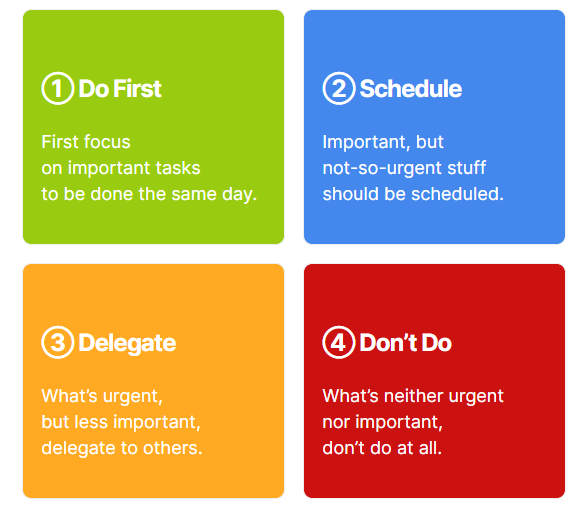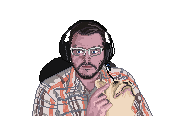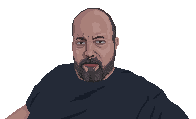Week's 11 and 12: Finalising and Recording the Pitch and Adjourning
- Will Ward
- Aug 23, 2021
- 4 min read
The final two weeks of the module were filled up with with discussions and meetings to finalise the pitch content and record our individual audio comments.
We had previously agreed to change the presenting order and individual slides and I ended up working on the slides explaining why we chose pixel art, why we chose the genre / business model and who was in the team and what they've worked on.
After drafting what would be my initial transcript, I gathered feedback from the rest of the team altering where needed and also offered my own when asked. I believe that this cohesive approach helped to create a more complete and in-depth pitch that would respond to the practice feedback and deliver.
As a final touch, I also created pixeled avatars for each member to use on the team slide:
Images 1-4: Team avatars (Will Ward 2021)
Adjourning
In 1975 Tuckman refined his theory by adding a fifth stage to the 'Forming, Storming, Norming, Performing' model: Adjourning.
Adjourning, is the break-up of a team, one their task has been completed successfully, at this stage it is important to achieve positive closure as members that have bonded may feel threatened, insecure and possibly a sense of loss and lack of motivation.
Because of this, it is crucial to acknowledge everyone's effort and celebrate successfully completing our goal.
Overall, the project was a solid success with every member of performing well and delivering on what was required for the final sprint, from; concept art, in-game assets, coding and gameplay revisions as well as adding their own input into the various supporting documents.
I believe that was possible due to both the bond that was shared from surviving the initial conflict of the team losing its team leader as well as the eventual segregation of roles and tasks due to the smaller team.
An interesting comparison with game dev Spry Fox (Fray 2021) could be made, where by keeping their team to a handful of specialist roles - in which each team member is working exclusively within their own specialism - it was found that communication was improved, albeit at the cost of production time and narrower viewpoints.
Early on, there was a lot of regular informal communication amongst all members - a lot of discussions over discord with impromptu video conferences. However, it could have been useful to have more regular structured contact with certain team members, but this was difficult due to vastly different time zones and outside commitments - despite everyone's best efforts.
I believe that this may have had an impact early on, along with the (unfairly) perceived lack of effort may have also contributed to the early pressures that led to the original team leader quitting and as meetings were missed and rescheduling was difficult.
This also meant that every task was unstructured, but also urgent with prioritising left to the individual, as scheduling became difficult and delegation was non-existent.
It is also possible that the lack of meaningful and productive communication during this time contributed to uncertainty of roles and actions and initially led to the overlapping of tasks and some friction between members.
Communication that effectively prioritised by by urgency and importance (Eisenhower 2011) rather than unplanned additions added to the already bloated workflow may have been more effective and reduced self-inflicted.

Image 5: The Eisenhower Matrix (Eisenhower.me, 2011)
Communications became more organised and formal later on with instructions and goals being clearly set out via regular emails, as the new team leader took charge and the team began to perform. Additional support was available through one to one discussions and communications, which helped to clarify any queries.
Despite individual effort being questioned early on, I believe that everyone was fully committed to make things work. This commitment was further enhanced once the new team took shape with work generally being submitted in a timely manner and allowances made for outside commitments, with improvements as the project went on.
One potential area I'd identify for improvement for the project would be the narrative link to the demo's core gameplay loop, as I felt that this remained under developed - despite plenty of action being taken.
This is something that I could have spoken up about sooner (and probably contributed to more) during the early to mid development. Because of this I would question my own ability to confront potential conflict, as although I felt able to give my opinion in all of our communications, I should have broached my concerns of the demo structure earlier and this may have led to a more realised final product.
Pitch and gameplay video The final pitch and gameplay video can be seen below:
Conclusion
The co-creative development module has been both a stressful and rewarding learning experience, but also enjoyable one overall. Despite a disruptive start, the team managed to pull together and complete what we had started. Overall, I feel that we can all be proud of what we achieved.
Trust had grown and the team was well on its way to becoming a high performing team, with complimentary skills and each member being totally committed to the end goal. It was a pleasure to work on this project with such supportive, likeminded and talented individuals and I would not hesitate to collaborate again with them should the opportunity arise.
I do end this module much the same way as I started it; however, exhausted but excited for next module and the challenges it brings with it.
On a final note, I need to say that our team leader did excellent work combining all of our materials for the final pitch into one cohesive presentation video that really captures the essence of what we were trying to create.
References:
EISENHOWER (2011). The Eisenhower Matrix: Introduction & 3-Minute Video Tutorial. [online] Eisenhower. Available at: https://www.eisenhower.me/eisenhower-matrix/. [accessed 28 Jul 2021]
FRAY, Andrew (2021) ‘Week 9: Spry Fox – “Innovate in Your Pants”: Co-Creative Design & Development Practice GDD730 20/21 Part-Time Study Block S3’. [online]. Available at: https://flex.falmouth.ac.uk/courses/913/pages/week-9-spry-fox-innovate-in-your-pants?module_item_id=54740 [accessed 27 Jul 2021].
Chapman, A. (2021). Tuckman: Forming, Storming, Norming and Performing - BusinessBalls.com. [online] Businessballs.com. Available at: https://www.businessballs.com/team-management/tuckman-forming-storming-norming-performing-model/. [accessed 28 Jul 2021]
Piercy, C.W. and Ph.D (n.d.). Teams as Systems. [online] teams1.pressbooks.com. Available at: https://teams1.pressbooks.com/chapter/teams-as-systems/.
Images:
Image 1: PL Avatar (Will Ward, 2021)
Image 2: PL Avatar (Will Ward, 2021)
Image 3: PL Avatar (Will Ward, 2021)
Image 4: PL Avatar (Will Ward, 2021)
Image 5: The Eisenhower Matrix. Eisenhower (2011) : Available at: https://www.eisenhower.me/eisenhower-matrix/.
Video:
Land, P (2021). Keep it Burning Pitch + Gameplay. [online] Available at: https://www.youtube.com/watch?v=goSnxjTrnCs [Accessed 23 Aug. 2021].







Comments